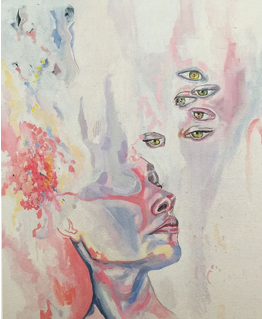Creating With... Kim Mintz
I had personally been following Kim Mintz on Instagram for several years now. I’d like to say that I had simply stumbled across one of her paintings in my feed but if I call recall correctly, I had delved five profiles deep on Instagram, searching for unique photography as I was suddenly ercome with a hunger for beautiful aesthetics. I shortly found myself on her page where I discovered her conceptual and impressionistic portraits, with eyes detailed to an extent of pure realism.
At the young age of 23, Kim Mintz is an impressive abstract artist well on her
way to success. After receiving the Sol and Debra Majteles Visual Arts Award in
her final year of high school, Kim is furthering her studies as an honours
student in Fine Arts at Curtin University, and holds a strong artistic presence
on social media. Recently Kim held an exhibition presenting her series Fragments to the public which discusses
social media’s contribution in presenting one’s identity.
I have been honoured with opportunity to discuss Kim’s interesting, thought provoking work, and the inspirations behind her ideas.
Fragments is a unique series
consisting of abstract portraits, with beguiling distortions of the human
portrait. Please discuss the meaning you are conveying in your series.
At first ‘Fragments’ was about the dichotomy between one’s
online identity verses offline.
Upon starting my post-graduate Honours degree in Fine Art,
where I was critically analysing
my paintings, I realized it was more about the proliferation
of images in a post-internet
context, and specifically the image-based nature of social
media platforms like Instagram.
I’m interested in how the human face has become a common
vernacular for representing
identity online, and how these self-images are very much
like self-portraits. In an age where
there are more images of ourselves than ever, I reference
the multiplicity of images through
the multiple faces within my portraits. The fragments became
symbolic for pixels, which
build up the faces in my portraits, reflecting a digitized
self. In platforms like Instagram and
Snapchat, images are a language through which people communicate
and talk to each other,
as well as reflecting the ideas about the self.
This proliferation of self-images is not inherently negative; I think it’s interesting that our identities are becoming increasingly digitized. It’s basically a commentary on what is happening around me, including the nature of my own social media activity.
How did you come to
create the series? Is there a particular experience or thought that had
inspired you?
I used to just take photos of my friends to paint with my
iPhone, and I remember one time I
tried taking a photo with the panoramic setting. You know
when you’re taking a panoramic
photo and you adjust your hand slightly and the image
becomes super weird and distorted? I
tried taking an image of my friend on that setting, moving
my hand up and down to distort it,
and the images came out extremely pixelated with multiple
eyes and noses. That became my
continual methodological process when creating my portraits,
as I thought it went hand in
hand with my concept of the proliferated networked image.
Then when I started thinking of
social media images as
self-portraits, I was increasingly interested in representing something as
prolific and contextually significant as social media through my practice.
Please tell us about
how you came to start creating art. Were you always aware that you
wanted to be an
artist?
I have always been interested in art, and took classes from
a very young age. I originally
started a degree in nutrition, as I was worried about
establishing a career as an artist, but
when I spent all my study time making art I realized I was definitely in the wrong course.
Has oil on canvas
always been your preferred medium? Were there any attempts with other
forms?
I originally started off just sketching with pencil on
paper. I really got into oil paints in high
school and I fell in love with the medium, I don’t think
I’ll switch to anything else.
Some painters I admire are Jenny Saville, Ben Quilty and
Loribelle Spirovski because of their
distortion in their portraits. I also look up to Petra
Cortright and Ken Okiishi for their digital
artwork as I think we share some of the same ideas about the
internet and social media.
I notice that in your
work the colours used are reoccurring - usually pink tones, red and
blues. Is there a
particular reason these colours resonate with you and your work the most?
I like using a variety of colours for the skin, also greens,
purples and oranges. Lately I’ve also
been using blue for the background to reference the blue
light that’s emitted from screens.
What are your goals
for your work?
I guess getting more solo exhibitions would be my goal for next year, if we’re talking long term it would be to quit my shitty job and be self-sufficient from my art.
You have had two
recent exhibitions - an opening exhibition at the Ellis House
Community Art Centre, as well as some displays I believe at the Moon
Café. This is extremely impressive for someone so young. Is there anything you
wish to say to other aspiring artists?
I always feel like there are young artists who have achieved
so much more than I have, it’s
hard to focus on your own journey sometimes. I guess I would
say to push through all the
existential crises and keep persisting, sometimes you won’t
get in to the gallery you wanted
or win the art prize you wanted, but if you love it enough
you’ll keep going and gain success
in other opportunities.
For more information about her work
you can reach Kim by Instagram (@kmint_art) or email (kimmintz2@gmail.com)







Comments
Post a Comment